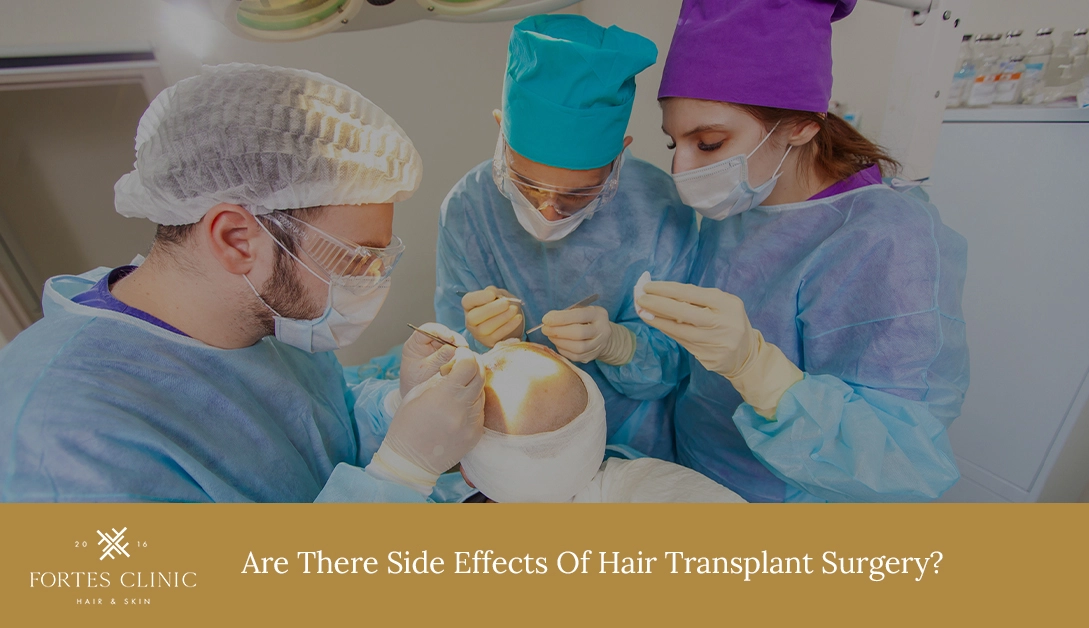Introduction
Hair transplant surgery is increasingly popular, with more people seeking permanent solutions to hair loss. While the procedure can offer life-changing results, it’s important to understand that, like any surgery, there are potential side effects of hair transplant procedures. Knowing what to expect and how to manage these side effects can help make the process smoother and less stressful.
Common Side Effects of Hair Transplant Surgery
Most side effects from hair transplant surgery are temporary and usually resolve within a few days or weeks. However, it’s essential to be aware of what you might experience during the healing process.
- Scalp Swelling: Swelling of the scalp is one of the most common side effects of hair transplants. It typically occurs within the first few days after the procedure and usually lasts for three to five days. Swelling may extend to the forehead or around the eyes, but this is normal. Cold compresses and keeping your head elevated can help reduce swelling. In some cases, your surgeon may prescribe medication to help with the discomfort.
- Pain and Discomfort: It’s normal to experience some pain and discomfort after a hair transplant, especially in the areas where the hair was harvested and implanted. Most patients describe the pain as mild and manageable. Your surgeon will likely recommend over-the-counter pain relievers, such as paracetamol or ibuprofen, to ease any discomfort. Prescription painkillers may be given if necessary.
- Itching: Itching is a natural part of the healing process and occurs as your scalp begins to heal. Although it may be tempting to scratch, doing so can dislodge grafts and delay recovery. To relieve itching, your surgeon may advise using a mild moisturising lotion or prescribed medication. It’s essential to follow post-operative instructions to prevent complications from scratching.
- Scabbing and Crust Formation: After the surgery, small scabs will form around each hair follicle. This is a normal part of healing and usually occurs within the first week. It’s crucial to keep the area clean, as instructed by your surgeon, to allow these scabs to fall off naturally. Avoid picking at the scabs, as this could lead to infection or damage to the newly transplanted hair follicles.
Possible Complications After Hair Transplant Surgery
Though rare, some patients may experience more serious side effects following a hair transplant. These complications are usually manageable with the proper care.
Infection
While infections are uncommon, they can occur if the scalp is not kept clean after surgery. Signs of infection include redness, increased swelling, pain, and oozing from the surgery site. If you notice any of these symptoms, contact your surgeon immediately. Antibiotics are typically prescribed to clear the infection and prevent it from spreading.
Bleeding
Some minor bleeding is expected immediately after the surgery, especially in the donor and recipient areas. If bleeding occurs after this period, applying gentle pressure to the area can help stop it. Persistent bleeding should be reported to your surgeon.
Shock Loss
Shock loss refers to the temporary shedding of transplanted and existing hair following surgery. This occurs as the scalp reacts to the trauma of the procedure. While it can be concerning, it’s important to note that shock loss is usually temporary, and the hair typically regrows within a few months.
Long-Term Side Effects of Hair Transplants and Risks
Although rare, there are a few potential long-term side effects that patients should be aware of when considering hair transplant surgery.
Scarring
Scarring is inevitable with any surgical procedure, but its extent can depend on the method used for your hair transplant. Follicular Unit Transplantation (FUT) often leaves a linear scar at the donor site, while Follicular Unit Extraction (FUE) typically leaves tiny dot-like scars. Skilled surgeons can minimise scarring, and it is often concealed by hair growth. Following aftercare instructions can also reduce the risk of noticeable scarring.
Folliculitis
Folliculitis, or inflammation of the hair follicles, can occur after a hair transplant. This usually presents as small, red bumps around the transplanted follicles and can cause discomfort. Mild folliculitis often clears up on its own, but more severe cases may require antibiotics or other treatments from your surgeon.
Numbness
Some patients report a loss of sensation in the scalp following surgery. This numbness is typically temporary and affects the areas where hair has been harvested or implanted. It occurs as a result of nerve disruption during the surgery and usually subsides within a few weeks to months. Permanent numbness is rare.
Factors That Influence Side Effects of Hair Transplants
Several factors can impact the severity and likelihood of side effects after a hair transplant. Understanding these can help you prepare for surgery and manage your expectations.
- Skin Type: Different skin types can react to surgery in various ways. For example, people with sensitive or oily skin may be more prone to infections or inflammation. Your surgeon will assess your skin type during the consultation and advise you on specific care steps to reduce the risk of side effects.
- Surgeon’s Expertise: The skill and experience of your surgeon play a crucial role in reducing the likelihood of side effects. Choosing a highly qualified and reputable clinic ensures that the procedure is carried out with precision and care, minimising the risk of complications.
- Post-Operative Care: Following your surgeon’s post-operative care instructions is vital in preventing side effects. Proper cleaning of the scalp, avoiding strenuous activities, and taking prescribed medications will all contribute to a smoother recovery process.
How to Minimise the Risk of Side Effects of Hair Trasnplants
While it’s impossible to guarantee a completely side-effect-free experience, there are steps you can take to minimise risks and ensure the best possible outcome.
Choosing the Right Hair Transplant Clinic
Selecting an experienced and reputable clinic is one of the most critical factors in reducing side effects. Look for clinics with a proven track record and experienced surgeons who specialise in hair transplants. Reading reviews and testimonials can provide insight into others’ experiences.
Following Post-Operative Instructions
Adhering to your surgeon’s aftercare instructions is essential for a smooth recovery. This includes taking prescribed medications, using special shampoos, and avoiding activities that could strain your scalp. Your surgeon will provide a detailed aftercare plan, and following it closely will help reduce the risk of complications.
Regular Follow-Up Appointments
Attending follow-up appointments is important to ensure your scalp is healing properly and to address any side effects that may arise. Your surgeon will assess your progress and recommend any necessary adjustments to your aftercare routine.
When to Contact a Doctor
It’s essential to know when to seek medical advice if you experience any side effects after surgery.
Signs of Complications
If you experience excessive pain, persistent swelling, redness, or signs of infection, contact your doctor immediately. Early intervention can prevent more serious complications.
Steps to Take if Side Effects Occur
If you notice any unusual side effects, such as prolonged bleeding or severe itching, consult your surgeon for guidance. They can recommend appropriate treatments to address the issue before it worsens.
Recap
Hair transplant surgery can offer a permanent solution to hair loss, but it’s important to be aware of the potential side effects. While most are mild and temporary, understanding how to manage them can ensure a smoother recovery. By choosing an experienced clinic and following post-operative instructions, you can minimise the risks and enjoy the long-term benefits of your hair transplant. Always consult with a professional to ensure that you are fully prepared and informed before undergoing the procedure.



